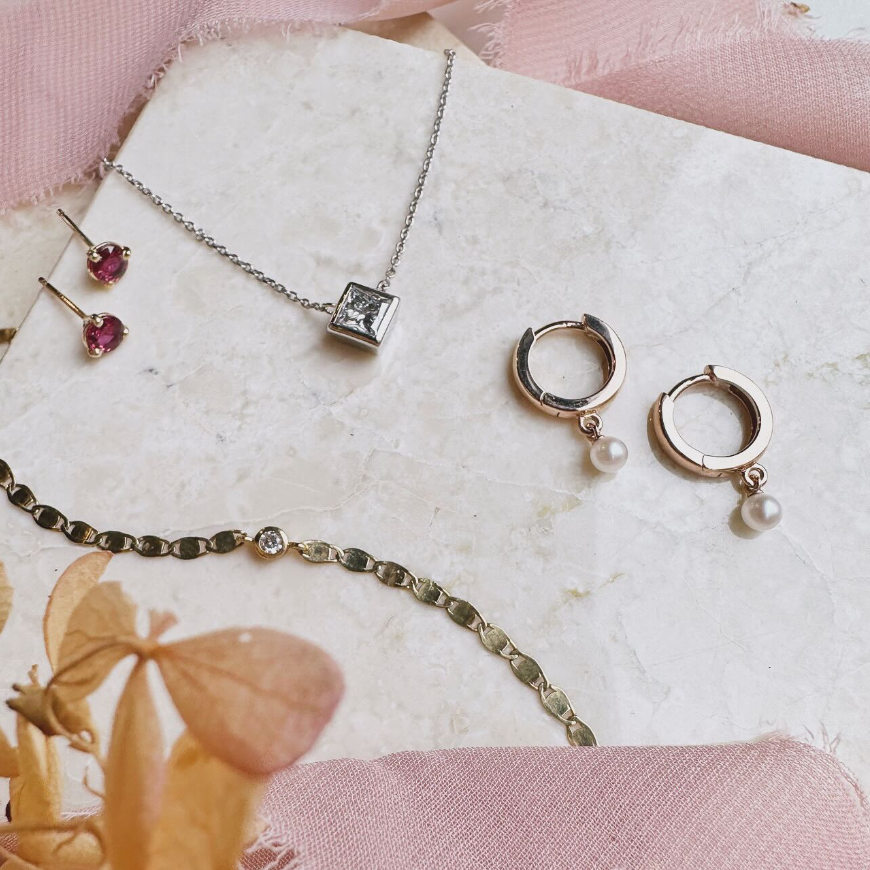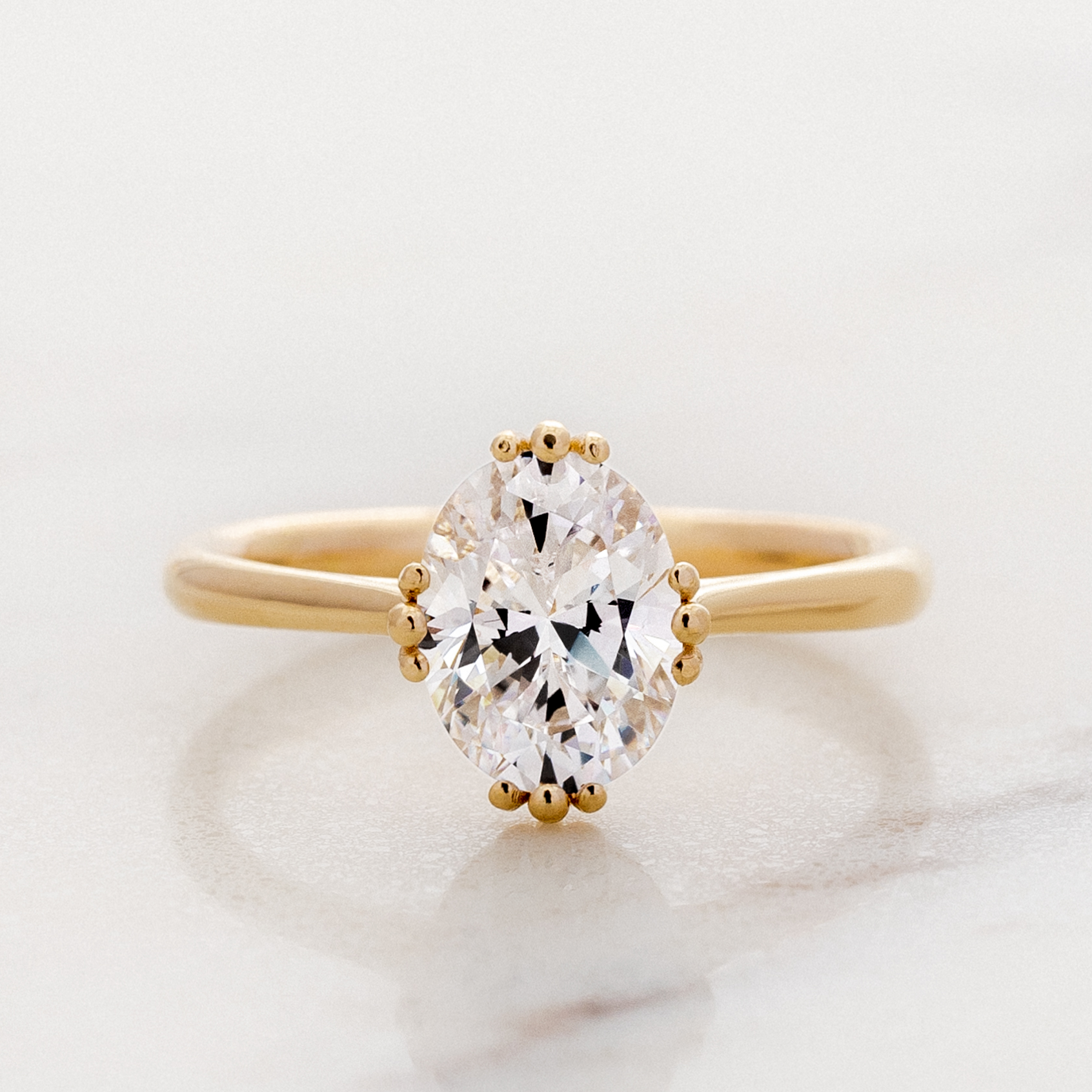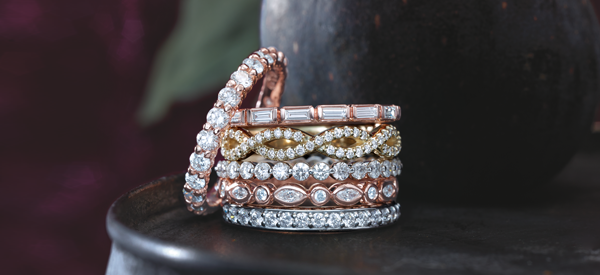Choosing a Ring Style
When it's time to shop for an engagement ring, you're on the hunt for two major elements; the center stone, and the ring mount. On this page, we'll talk about the basic elements of an engagement ring mount, which you can mix and match to create a unique design with all the perfect details!
Basic Styles
Almost all rings can be sorted into one of 4 main categories: solitaire, side stone, halo, and cluster. Below is a very simple example of each, but within each category there are many variations and details that can be customized. With any style, the band can be many different shapes, and have small accent stones, filigree, or other design details.
Solitaire

Side Stone


Sometimes called a 3 Stone ring, this design features a smaller stone on either side of the center stone. They can be the same shape and color, or different than the center stone to add contrast.
Halo


A halo refers to a ring of diamonds around the center focal stone - literally a ring of light (hence the name). The stones used in the halo can be different sizes, colors, and shapes - but the most common is a simple halo of small round stones. You can also add side stones, either within the halo or to either side of it.
Cluster


A cluster ring is many stones making up one overall design. There is often one larger focal stone, with smaller stones creating a cluster around. Recently, asymmetrical clusters have become very popular.
Setting Style for the Focal Stone(s)
There are two main methods of stone setting for the main focal stones of your ring. This would include the center stone as well as any larger accent stones like side stones, or stones in a cluster.
Prongs

Prongs are small pieces of wire that hold the stone in place. Four prongs is sufficient to hold a stone in place, and 6 or 8 prong rings are also popular (but better for larger stones). Popular prong styles are round or claw prongs, and the layout of the prongs can be customized.
Bezel


A bezel is one smooth piece of metal that goes all the way around the stone. This setting is popular for people who are very active, as it's very secure and has no high points to get caught and pulled open. Some bezels feature additional detail like beading or milgrain (shown in the three stone ring above).
Setting Styles for Small Accent Stones
When using small stones in a band or halo, there are a few different setting styles to choose from. The three main choices are bead set, split prong, or channel.
Bead Set


Bead set stones have a solid, smooth rail of metal on either side, and are held in by teeny beads of metal (like very small prongs). Details like beading can be added to the rails that frame the stones (shown on the band above)
Split Prong


In split prong setting, the metal is barely wider than the stones themselves, so you see as little metal as possible, putting the focus on the stones. Each stone is held in with 4 small beads, and the side view has a lovely scalloped design. This style is also called "french cut" or "French set."
Channel

This is like a version of bezel setting for diamonds that are in a row, where two smooth rails of metal on either side hold the stones in place.
Metal Choices
There are many metals to choose from for your engagement ring, it breaks down to three main colors: yellow, pink, and white.
Yellow Gold

14k yellow gold is a beautiful color, and the most popular choice when clients love the look of yellow gold. 18k yellow gold has a richer yellow color, but is also softer and scratches more easily.
Rose Gold

Rose gold is alloyed with copper to give it a red, rosey tone. It's become very popular lately. 14k is the most popular choice, but 18k is available as well.
White Gold

White gold is available in 14k or 18k, and is a hardy metal that is relatively scratch resistant. All white gold is plated with rhodium, which helps to give it a bright white finish and creates a barrier that can help with nickel allergies. If someone has a severe nickel allergy, there are special alloys like palladium white gold that remove the nickel entirely.
Platinum

Platinum is the other choice for a white tone metal, although it has a slightly more grey tone than rhodium plated white gold. It is more malleable than white gold and can get deep scratches more easily, but it is completely hypoallergenic and free from nickel. It's also a more dense metal, so tends to be more expensive. Compared to white gold, the density also means that it wears differently over time and the malleability means is less likely to crack and break when put under extreme pressure. Platinum does not need to be plated, the only maintenance needed is occasional repolishing because it does get scratches more easily.






